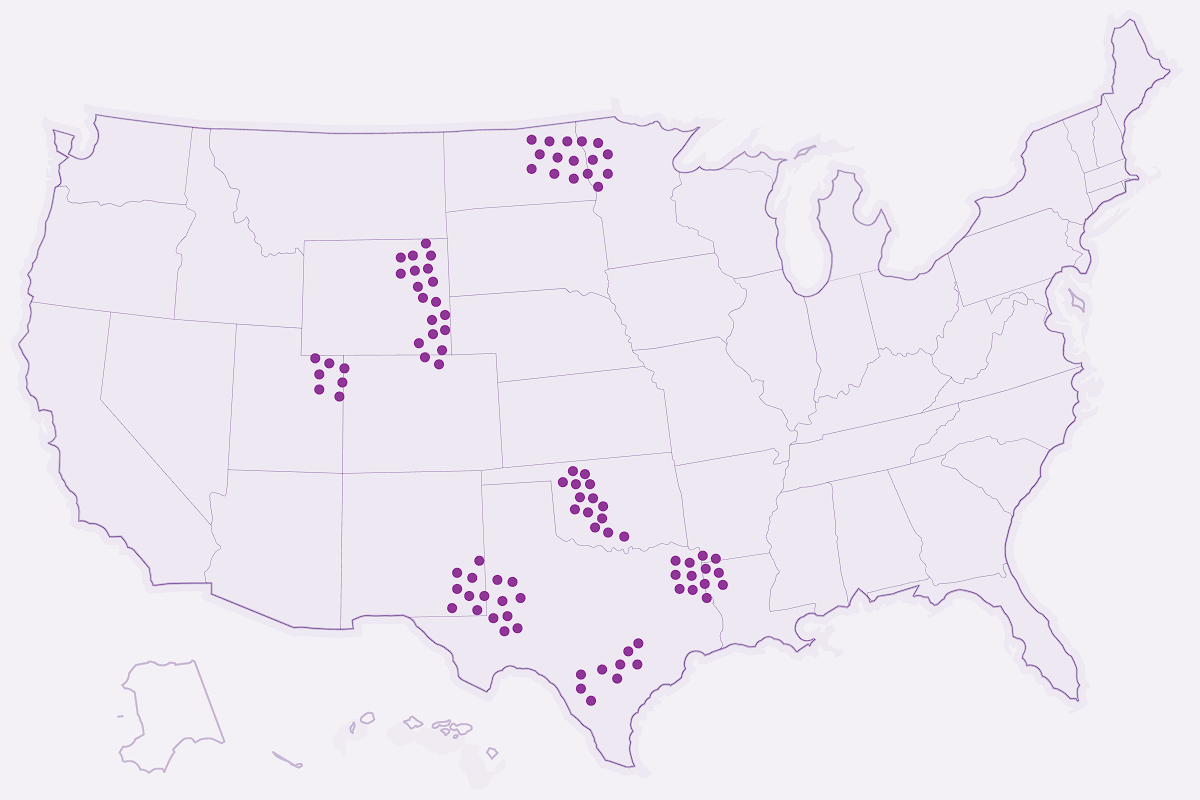Fracking has disrupted the oil world. Over the last decade, U.S. daily oil production has increased by 260 percent to 13,000 barrels a day. In the U.S., now the world’s top oil producer, average royalty shares of 12.5 percent, are reaching 25 percent in high production regions.
Royalty trusts and MLPs are among the public investment vehicles actively investing in mineral leases to gain exposure to high producing basins like the Permian. We should add to these large cash pools hedge funds, venture capital funds and family offices.
Royalty trusts and MLPs are among the public investment vehicles actively investing in mineral leases to gain exposure to high producing basins like the Permian. We should add to these large cash pools hedge funds, venture capital funds and family offices. Debt financing is cheap and more readily available to E&P companies. Alternative and structured financing are lending alongside debt capital. These financing vehicles are filling the coffers of junior mining companies actively seeking the next big deal in an active fracking state like Oklahoma or Texas.
The majors are consolidating acreage to improve the production capacity and scale of horizontal drilling. Shell, BP, ExxonMobil and others are buying up property to streamline operations.
New pipelines coming online by 2022 in the Permian Basin – the epicenter of the shale boom – will clear backlogs and boost mineral extraction. A new pipeline from the Permian, Delaware and Eagle Ford Shale plays is now connected with
Mineral owners can monetize their interests by leasing or selling mineral rights. Less commonly, the owner sells options on the right to buy mineral rights, and even if the options are not exercised, pockets the options fees.

As a fee simple property owner, you may or may not include surface rights with the sale of your mineral rights.

Potential revenue streams from leasing include a signing bonus in exchange for granting the right to explore for minerals and royalty payments if the lessor extracts them.
If your mineral rights are located in a high producing basin, chances are buyers are contracting you directly and making offers.
The best way to ensure you are being offered the maximum market price is to consult other resources.
By listing on a mineral listing service with lots of active buyers and sellers, you can discover what price the market assigns your mineral rights. However – if you enter mineral rights transactions directly, you face many risks, including fraud, counterparty creditworthiness, and so on.
Mineral properties that are auctioned often go for a higher price due to the higher volume of bidders. A reputable auction platform will vet buyers to ensure they are creditworthy and can close the deal.
A broker, who may use either one of these channels, will know how to sell your mineral assets at the best price. An experienced broker will be able to extract more value by strategically aligning your property with the interests of qualified buyers.
Your assets, for example, may be worth more to their oil fracking client who is quietly buying up neighboring interests in New Mexico, North Dakota, Texas, West Virginia and other active basins.
In addition to entering lease agreements to conduct E&P activity, they are actively selling mineral rights as a form of financing and, in turn, payout distributions from project cash flows to the trust shareholders.
A trust diversifies risk across many leases, pooling royalties into income streams paid out to investors, similar to dividends. But because they tend to only hold onto leases until royalties decline alongside reserves, income can be volatile.
Different from royalty trusts, MLPs actively grow their asset base. Because the dividend payouts are more stable than those of royalty trusts, MLPs are quickly attracting investor funds.
Private buyers are more willing to negotiate directly with a mineral rights owner. They seek higher yields and will often make the most attractive offer.
Pheasant Energy and its affiliates participate in mineral rights in all these forms – investing as public trusts and private LPs, as well as acting as an owner/operators and managers of interests in mineral resources. This comprehensive view of market activities allows us to execute quickly as opportunities arise.
The leasing model is commonly used in the oil and natural gas industry. The biggest drawback is royalties will not be paid if the mine is not productive. And even if minerals are found, producing them could be uneconomical.
Receive a steady income stream in the form of lease payments (8 to 25 percent)
Receive a lease bonus as a sweetener
Invest proceeds in higher returning asset class
Mineral rights eventually revert to the owner
Low royalties, if production is low
No royalties, if no minerals are found
Declining lease payouts
Depletion of mineral deposits before lease expiry
Could be locked into low revenue wells and lease extensions for a fixed period
Taxes due on actively producing wells
Large upfront cash payout, regardless of future output levels
Do not assume future price or development risks
Invest proceeds in higher returning asset class
May sell rights to minerals infractions and retain some ownership
Forego future appreciation in mineral assets
Surface land without rights will worth less in future
Third-party buyer controls surface rights for E&P activity
How is the leasing and sale of mineral rights taxed?
Another essential difference is taxation treatment. The lease bonus and royalties are treated as regular income for taxation purposes. In contrast, on a sale you will be taxed on the capital gains. For more information, feel free to check our guide on how mineral rights are taxed.
The most considerable risk of leasing is if no production activity takes place, and the lease expires. In this case, full ownership of the rights reverts back to you. In the worst-case scenario, you may no longer have an exit strategy if production cools off and you cannot sell outright at the same high values.
The timing of selling your mineral rights often comes down to your personal financial situation. Whether your assets are producing or non-producing and when they will be producing in the future will impact your future income streams, and ultimately your decision whether to lease or sell your mineral rights.
A change in family asset ownership
Inheritance of mineral property is one of the most common reasons to sell your rights. Divorce and probate family issues are others. The inheritors may choose to monetize their interests for personal finance, real estate or estate planning reasons.
Inconsistent lease payments
Erratic lease payments may not be aligned with your medium-term (house deposit, college savings) or long-term (retirement) savings goals. Selling your mineral assets will allow you to place the funds in lower risk diversified investments.
Fractionalization of mineral rights
Inheritance can fractionalize property ownership across two or more inheritors. This type of distribution often creates conflicts, as well as tax and administration burdens. Alternatively, the mineral interest could be divided up, and each owner can choose leasing or sale as it suits them.
Better market opportunities yonder
You may choose to sell rights on non-producing reserves and invest directly or indirectly in mineral property elsewhere.
Risk tolerance
Can you tolerate income payments streams whose volatility, decline rate and termination dates are undetermined?
Income requirements
Do you require a steady income stream today, or can you wait for future production to come online?
Estate planning implications
Tax implications
Production, drilling and permitting activity on your or adjacent land all minimize the degree of unknowns associated with mineral exploration and development and therefore make your rights more saleable. Catalysts to sell could include:
New activity and/or an increase in production activity in a region – Have neighbors started to drill or produce actively?
Favorable financing terms – Low-interest rates make it more economical to invest in and finance E&P projects.
Institutions and funds are increasing investment in your region/minerals – If money is flowing into the sector, operators will find it easier to secure financing to increase exploration and development activity.
Royalty trusts – The trusts, who may pay more per royalty acre, will follow closely behind.
New extraction technologies – Horizontal drilling and other improved extractions methods are making more projects economically viable.

Thorough due diligence can uncover hidden treasures beneath your earth. The production and price level are key determinants in mineral leasing valuation.
Still, most of the time mineral rights value remains under the ground, untapped due to inefficient due diligence. Your interests may be worth more than you have assessed, and be more saleable in the current market.

New technologies that may provide the opportunity to improve extraction, and tap into more and larger payment streams
Adjacent drilling permits that may be encroaching on your reserves, for which arrears may be due
Active production that may be occurring but is not captured in lease payments
Loopholes in complex leasing and purchase agreement terms – leading to unfair cost allocation, for example – that may result in your full producing share in mineral leases not being paid
Conflicts and misinterpretations between federal and state laws
In highly productive areas where valuations are soaring and many wells are being drilled in close proximity, these oversights are more likely to occur.

Misleading contact terms are common. You may be selling royalty interests (royalty acreage) but the fine print is for the sale of both your royalty and mineral interests (mineral acreage).
Lack of knowledge and an unequal playing field can lead to wrong comparables being used.
Disguising term deeds and royalty leases as legal rights to minerals are some of the many fraudulent and deceptive activities used by mineral buyers to scam sellers.
Mineral sales are too complex for the inexperienced seller to negotiate the best contract terms.
Conducting proper due diligence on the multitude of factors affecting mineral rights worth takes time.

From shale percentages to royalty payments and shares, all your risks are covered in unambiguous contract language.
The identification of the fair market value and hidden, untapped value will ensure you get the full amount for your mineral rights.
Avoid selling the farm, as the old axiom goes. Sell only to reputable buyers who have passed stringent due diligence tests.
Avoid contracted negotiations and unnecessary concessions – and worst, being duped by a shady mineral rights buyer – by having industry experience behind you.
Based on our deep industry experience and network, at Pheasant Energy, we transact faster than anybody else.
75+
1000+
100K+
Risks lurk everywhere when selling mineral assets.
At Pheasant Energy, we bring 360-degree insight into mineral rights sales as a broker, manager, and investor in oil and natural gas mineral rights.
From these different strategic viewpoints, we analyze a high volume of opportunities at any one time.
No need to look back with regret when you entrust us to extract the highest value from your mineral rights sales.

Since 1930’s
Pheasant Energy is primarily a non-operating oil and gas company, with the exception of joint ventures in working to develop existing positions and those within our management division.